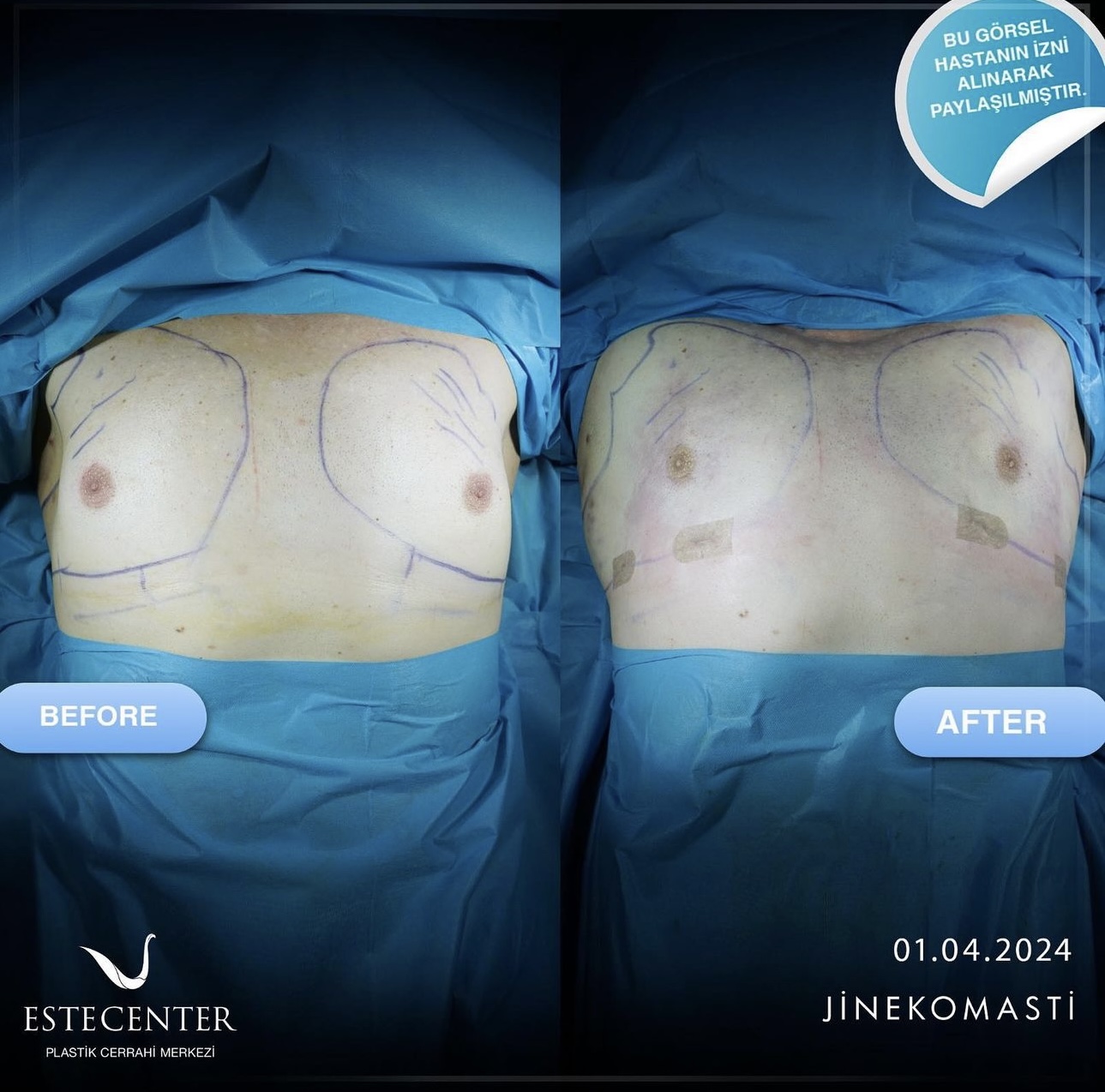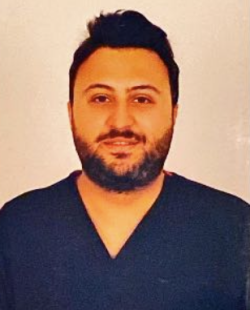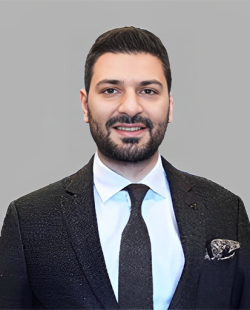Before & After

Gynecomastia Surgery
Male breast enlargement is a very common health problem. This type of growth can have many different causes. In the treatment of male type breast enlargement, also called gynecomastia, the problem causing the enlargement must first be found.
Afterwards, in an operation performed by Plastic, Aesthetic and Reconstructive Surgery specialists, excess fat and/or breast tissue in the breast is removed, allowing the area to regain its normal appearance. What causes gynecomastia, that is, male type breast enlargement? What are its types? How is it treated? You can find the answers to many frequently asked questions in our article.
- Latest Technology
- Expert team
- Specialist Doctor Staff
- 20 Years of Sectoral Experience
What is Gynecomastia (Breast Enlargement in Men)?
Gynecomastia, also known as gynecomastia or breast enlargement in men, is a problem that occurs due to hormonal changes or imbalances. If the amount of testosterone in the body decreases or the amount of estrogen increases, gynecomastia may occur in men. This problem, which is a hormonal change, can occur due to many different factors.

The growth of breast tissue in men is called gynecomastia and is an extremely common condition. Breast enlargement may occur in men due to hormonal changes, other disorders or medications used. Male breast enlargement can occur on one side or on both sides. Gynecomastia occurs frequently in three parts of life, especially after birth, adolescence and old age.
Immediately after birth, the estradiol and progesterone levels secreted by the mother during pregnancy are quite high, and these hormones enable the development of breast tissue. After a while after birth, gynecomastia disappears on its own. It may occur again during adolescence due to changes in hormones. Today, gynecomastia is observed in approximately 60% of 14-year-old boys. The vast majority of these are bilateral. However, sometimes it can be asymmetrically unilateral.
Another period when gynecomastia is frequently seen is old age or those over the age of 65. Although it is not clear why it occurs in this process, it is thought that increased body fat and a more sedentary lifestyle cause male-pattern breast growth in old age.
What is Pseudo-Gynecomastia?
Pseudo-gynecomastia is known as the condition of excess fatty tissue behind, around or in the lower area of the nipples in the breast areas of men. Although this condition causes breast enlargement, it is not gynecomastia.
Gynecomastia Surgery Prices
Gynecomastia creates an aesthetically disturbing appearance for people. This situation causes patients to have gynecomastia surgery . The prices of the surgery performed to achieve aesthetically healthier and smoother breasts vary due to different factors.
Gynecomastia Symptoms
This problem, which occurs due to different reasons, can create an aesthetically disturbing appearance for patients.
Symptoms of breast enlargement in men include;
- Tenderness, pain or soreness in the breasts or nipples,
- Breast or nipple enlargement,
- The difference in size between the two breasts,
- Feeling uncomfortable when dressing and undressing,
All these factors are known as symptoms of gynecomastia.
How to Treat Gynecomastia?
Waiting and monitoring the process for gynecomastia treatment is among the options, as growth sometimes disappears on its own. At the point where there is no improvement, it is painful, and it disturbs the patient, surgical intervention may be considered by consulting a specialist. During gynecomastia surgery performed for treatment purposes, breast tissue or fat tissue is intervened.

Gynecomastia (Male Type Breast Enlargement) Treatment Methods
Breast enlargement in men can be treated with different methods. Only the doctor can decide which method is suitable for the patient, and treatment methods vary depending on the reason for this problem. Gynecomastia surgery is an effective solution to the breast enlargement problem in men.
Gynecomastia with Vaser Liposuction
Vaser liposuction, one of the operations performed for breast reduction in men, is an effective method. Fat tissue is broken down and removed from the breast. It is an option in which tissues are less damaged and bruising is reduced.
Which is the Best Gynecomastia Method?
It is not possible to give a single answer as to which method is best. Gynecomastia surgery prices and techniques performed during the procedure may vary depending on the patient. Only the specialist who will perform the procedure can decide which gynecomastia method is suitable for you.
How is Gynecomastia Surgery Performed?
Since male breast surgery is performed with anesthesia, the patient does not feel any pain or discomfort. Excess fatty tissue in the breast can be removed by liposuction. On the other hand, surgery is also possible with a method called mastectomy, in which breast tissue is intervened. The correct method is decided together with the expert.
After Gynecomastia Surgery
Istanbul gynecomastia surgery has become a subject frequently researched and wondered by patients experiencing breast enlargement in men. It is possible to say that there are various factors that need to be taken into consideration after surgery, which is a permanent and definitive solution to this problem.
It is necessary to approach physical activities carefully for a certain period of time after gynecomastia surgery . It is possible to experience some pain after this operation, where it may take a few days to return to daily life. In addition, it is normal to experience swelling and bruising in the chest area. In order to go through this process in the best way, it is important to take into account the advice and practices given by the doctor. It is also necessary to stay away from heavy sports during the recovery period after gynecomastia surgery .
How Many Hours Does Gynecomastia Surgery Take?
Those who have gynecomastia surgery state that the operation may take approximately 2 hours. However, this period may be longer or shorter due to various factors. Surgery, which takes varying periods of time depending on the patient’s condition and the scope of the procedure, is a preferred method for breast enlargement problems in men.
What Causes Male Pattern Breast Enlargement?
There are many different factors that can cause this problem. Many different factors such as liver diseases, obesity or tumor may cause gynecomastia problems.
Physiological Causes of Gynecomastia
Hormonal imbalances are among the physiological causes of gynecomastia, which can occur due to many different reasons. Breast enlargement may occur in men due to increases and decreases in hormones.
Non-Physiological Causes of Gynecomastia
Since gynecomastia is a problem that can occur due to many different factors, some physiological and non-physiological factors stand out. Non-physiological causes include having a harmful habit such as alcohol or drugs. Additionally, some medications and tumors may also cause this problem.
Gynecomastia has physiological as well as non-physiological causes. One of these reasons is pathological reasons. Testicular tumors may cause increased estrogen levels in the blood through excessive production of estrogen and androgen hormones and ectopic secretion of gonadotropins that stimulate normal Leydig cells. Leydig cell tumors, Sertoli cell tumors, granulosa cell tumors and adrenal tumors are examples of estrogen-secreting tumors.
Leydig cell tumors: Approximately 1% to 3% of all testicular tumors are Leydig cell tumors. It usually occurs between the ages of 20 and 60, but 25% of it can also be seen in adolescence. It is usually benign, but malignant Leydig cell tumors can metastasize in the lung, liver or lymph.
Sertoli cell tumors: Less than 1% of testicular tumors are Sertoli cell tumors. Although it can be seen at any age, one in every three patients develops before the age of 13. It can also be seen in male babies under 6 months of age. Although it is generally benign, the rate of malignancy is around 10%. Because it causes excessive estrogen production, gynecomastia occurs in one in every three Sertoli cell tumor patients.
Granulosa cell tumors: Granulosa cell tumors are the rarest testicular tumors and cause excessive estrogen production. For this reason, although it is rare, it can cause gynecomastia quite frequently in patients.
Adrenal tumors: Adrenal tumors may secrete excessive amounts of dehydroepiandrosterone, dehydroepiandrosterone-sulfate, and androstenedione, which can then be aromatized peripherally to estradiol. These tumors are typically large, aggressive, and malignant.
Along with tumors, non-physiological causes include medication, alcohol and drug use. Some medications can cause gynecomastia as a side effect. Additionally, avoiding drug use and limiting alcohol intake also reduces the risk of gynecomastia.
How to Diagnose Gynecomastia?
In order to diagnose male type breast size, the patient’s health history is first taken. It is also learned whether there is a similar situation in the family. In the diagnosis of gynecomastia, the abdomen and genital area can be examined along with the breast tissue. In some cases, blood tests and mammography are performed to obtain a successful result. In addition to these existing tests, advanced imaging technologies such as computed tomography (CT) and MRI scan are used during diagnosis.
Increased fat tissue, breast cancer, although rare in men, and infection in the breast tissue can cause similar results to gynecomastia. However, differential diagnosis can be made thanks to physical examination and imaging techniques.
What are the Types of Gynecomastia?
It is possible to state that there are three different types of gynecomastia: fluoride, fibrous and intermediate type. Gynecomastia price range may vary depending on what type of problem is experienced and the treatment.
Fluoride type is usually just the beginning stage of gynecomastia. It shows the changes that occurred approximately in the first four months. In this type, ductal tissue and vascularity increase.
Breast tissue and fat tissue are in varying proportions. The intermediate type is a one-year process and this process is considered as the transition period from the fibrous type to the fluoride type. In the fluoride type, there is stromal fibrosis, which is considered as tense connective tissue in the breast. Ductal tissue is few in number. It is usually seen more than a year after the onset of development in breast tissue.

Gynecomastia Stages
There are four different stages of male pattern breast enlargement. In the first stage, slight growth occurs around the nipple. In the second stage, the breast becomes slightly larger, causing discomfort to the patient. In the third stage, growth occurs noticeably. In the fourth, or last, stage, a real woman has an appearance that is indistinguishable from her breast.
- Stage: In the first stage, slight growth occurs in the tissue around the nipple or areola. Due to slight swelling, color variation may be observed in the tissues in this area. Generally, it cannot be noticed while wearing clothes, and if it is not permanent, no intervention is required.
- Stage: This stage is also known as intermediate gynecomastia. At this stage, the breast grows in chest width. People with second stage gynecomastia generally prefer to wear loose and loose clothing because they are uncomfortable with their appearance. In some cases, surgical intervention may be recommended at this stage. However, treatment methods such as weight loss or medication use may also be preferred.
- Stage: In the third stage of gynecomastia, breast enlargement is more noticeable. The amount of skin tissue increases with breast width. In the third stage of growth, loose clothing does not help to hide the appearance. When the condition becomes more visible, patients may feel insecure about their own bodies.
- Stage: In the fourth stage, which is the most advanced stage, the breast tissue grows and the skin tissue is also quite large. The appearance of the chest area is more reminiscent of the breast area of women. Surgical intervention is usually inevitable in gynecomastia at this level. However, non-surgical methods are still considered and evaluated first.
How is Male Type Breast Size (Gynecomastia) Diagnosed?
Male breast size can only be diagnosed by a doctor. During diagnosis, both physical and blood tests are performed. Successful diagnosis is very important for the diagnosis and treatment planning of the findings.
Gynecomastia Tests
Testing for gynecomastia involves physical examinations and different blood tests performed by doctors. These examinations are very important for a correct diagnosis.
Factors That Increase the Risk of Gynecomastia
Gynecomastia may be observed in some men due to daily life and habits. The most important of these is obesity. As a result of obesity, estrogen hormone is secreted more, which indirectly leads to male-type breast growth.
However, the use of anabolic steroids or androgens to increase physical and athletic performance also significantly increases the risk of gynecomastia. Another reason for this is excessive use of alcohol or illegal drugs. Limiting alcohol consumption to a certain amount also reduces the risk of gynecomastia.
Can Gynecomastia Be Treated with a Corset?
Especially people who are not satisfied with their appearance prefer to hide this appearance with a corset. However, the use of corset does not have any therapeutic effect. Generally, doctors recommend wearing corsets after surgery.
Protecting the chest area thanks to the corset makes the healing process more comfortable. In addition, support is provided to the upper part of the body. Gynecomastia corset serves as protection as well as support and protects the operation area from impacts to the chest area and ensures a shorter recovery time.
Is Gynecomastia Athlete a Solution?
One of the solutions used by those suffering from gynecomastia is the gynecomastia athlete. These athletes, which provide a flatter appearance by tightening and tightening the upper body, are frequently preferred. However, gynecomastia athlete does not provide a permanent solution or have any therapeutic properties.
In male type breast enlargement, the overgrown tissue then disappears spontaneously or is removed from the body through surgical intervention. After the operation, gynecomastia tank can be used with the doctor’s advice. While the healing process is shorter and more comfortable due to the athlete’s compression of the body, an extra layer also helps protect the sensitive operation area.
The use of athletes alone is not a treatment method alone. A product called gynecomastia athlete can be used after gynecomastia surgery. This product helps the post-operative recovery process.
When choosing sports after gynecomastia surgery, you should stay away from heavy sports and do only the amount of exercise recommended by the doctor.
Although the gynecomastia surgery recovery process varies from person to person, a recovery period of several months is required for visible results. If there are no complications, visible changes will occur after a while and the disturbing appearance that the patient is aesthetically concerned about will disappear.
Frequently Asked Questions About Dental Aesthetics
For this reason, people with advanced breast enlargement and sagging need surgery. Male breast enlargement is usually monitored. During this follow-up, gynecomastia surgery is seen as an option in cases where the growth does not regress or even progresses and causes not only physical but also emotional problems.
It takes many patients a few days to return to their daily lives. However, it is still necessary to stay away from activities that will increase blood pressure, especially for the first two weeks. It takes approximately two weeks to return to work that requires heavy physical strength. However, these processes are indicated by doctors.
It is expected that the scars of the operation will disappear completely within 1 year by following the doctor's recommendations and applying the necessary care to the area during the recovery period. The time it takes for the operation scar to disappear after gynecomastia with liposuction is shorter. What people who want to have male breast reduction surgery should not forget is that doctors take all necessary precautions to avoid leaving any scars in this operation.
Another period when hormonal changes occur is adolescence, and gynecomastia is observed in more than half of the men in this period. During adolescence, this process varies between 6 months and 3 years. Overgrown breast tissue then disappears on its own without the need for any treatment. Another period when gynecomastia is most common is in old age. One in every four men between the ages of 50 and 69 has male-pattern breast growth.
Reducing soft tissue damage in liposuction applications; Choosing the vaser liposuction technique, which makes both the operation and the post-operative period more comfortable, also affects the price. Gynecomastia surgery prices may vary depending on factors such as the expertise of the physician who will perform the operation and the fee policy of the center where the operation will be performed.
Returning to normal life after the operation should be gradual, regardless of the technique used. It is necessary not to tire the arms too much, to avoid heavy movements, and to stay away from areas that are both humid and open to public use, such as saunas and pools. Sports such as light-paced walking that will not tire the arms can be started 10 days after the operation. For heavy sports, it is necessary to wait about 2 months.
In gynecomastia caused by any tumor, the priority is to treat the tumor. However, after the causes of gynecomastia are treated, the operation needed to return the breast to its previous appearance is performed by Plastic Reconstructive and Aesthetic Surgery specialists.
Factors that determine the success rate in gynecomastia
Factors that determine the success rate of gynecomastia or male breast enlargement surgery;
correct diagnosis,
Personalized planning,
Proper healing process,
It can be expressed as performing regular checks. Since there are many factors that can cause gynecomastia to occur, it is imperative to correctly determine the cause of gynecomastia and eliminate this cause, which will be a priority for the operation to be successful.
There is no need for any medication or treatment during this process. Although this situation is temporary, it causes some young people to feel ashamed and insecure. In such cases, young people generally prefer loose and loose clothing. Breast enlargement usually does not cause pain or pain, but some people may rarely experience pain and these pains are controlled with various medications. Very rarely, surgical intervention is needed.
Surgical intervention is one of the solutions in cases where male breast enlargement causes both physical and mental disorders. In some cases, pseudo gynecomastia or false gynecomastia may also occur. This has nothing to do with puberty or hormones. Excessive amount of fatty tissue in the chest area can cause the appearance of male-type breast enlargement. This condition can be determined by a simple examination.
Treatment is required in cases where gynecomastia causes pain or tenderness or progresses rather than regresses. There are also treatment options in cases where a person is disturbed by his or her appearance. In cases where the disease progresses, not receiving treatment may lead to bigger problems in the future.
Meet Our Doctors
Table of ContentsToggle Table of ContentToggle
- Before & After
- Gynecomastia Surgery
- What is Gynecomastia (Breast Enlargement in Men)?
- Gynecomastia Surgery Prices
- Gynecomastia Symptoms
- How to Treat Gynecomastia?
- Gynecomastia (Male Type Breast Enlargement) Treatment Methods
- How is Gynecomastia Surgery Performed?
- How Many Hours Does Gynecomastia Surgery Take?
- What Causes Male Pattern Breast Enlargement?
- How to Diagnose Gynecomastia?
- What are the Types of Gynecomastia?
- Gynecomastia Stages
- How is Male Type Breast Size (Gynecomastia) Diagnosed?
- Factors That Increase the Risk of Gynecomastia
- Can Gynecomastia Be Treated with a Corset?
- Is Gynecomastia Athlete a Solution?
Call Me Back



